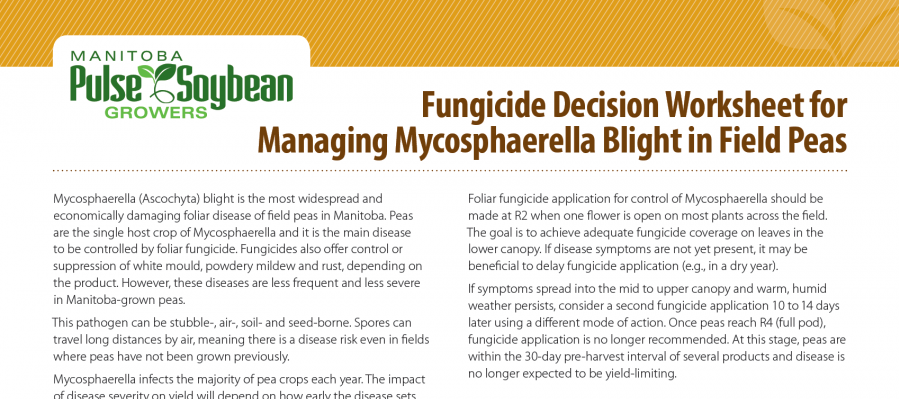Mycosphaerella (Ascochyta) blight is the most widespread and economically damaging foliar disease of Manitoba field peas. Peas are the single host crop of Mycosphaerella and it is the main disease to be controlled by foliar fungicide. Fungicides also offer control or suppression of white mould, powdery mildew and rust, depending on the product. However, these diseases are less frequent and less severe in Manitoba-grown peas.
This pathogen can be stubble-, air-, soil- and seed-borne. Spores can travel long distances by air, meaning there is a disease risk even in fields where peas have not been grown previously.
Mycosphaerella infects the majority of pea crops each year. The impact of disease severity on yield will depend on how early the disease sets in and how quickly it progresses into the upper crop canopy. Early infections during the bloom to early/mid-pod stages (R2 to R3) cause the most damage if left unchecked.
Cool, wet conditions promote disease development. Symptoms first occur in the lower canopy as small purplish-brown flecks or as large brown lesions with a concentric ring pattern. If favourable conditions persist, lesions will expand, produce spores and disease will develop up the canopy. The risk of yield loss increases when symptoms progress above the bottom third of the plant canopy by the R2 stage. Monitor closely for any upward movement of symptoms within the crop.
Scout for symptoms from V10 (10th true node) to R2 (beginning bloom), during mid-June to late July. Use this fungicide decision worksheet when scouting to determine if fungicide application is necessary.
Foliar fungicide application for control of Mycosphaerella should be made at R2, when one flower is open on most plants across the field. The goal is to achieve adequate fungicide coverage on leaves in the lower canopy. This means spraying just before the canopy begins to close. If disease symptoms are not yet present, it may be beneficial to delay fungicide application (for example, in a dry year).
If symptoms spread into the mid to upper canopy and warm, humid weather persists, consider a second fungicide application 10 to 14 days later using a different mode of action. Once peas reach R4 (full pod) fungicide application is no longer recommended. At this stage, peas are within the 30-day pre-harvest interval of several products and disease is no longer expected to be yield-limiting.
Additional Resources
- Identifying Mycosphaerella vs. Bacterial Blight Symptoms – Michael Wunsch, NDSU
- Foliar Fungicide Decision Making in Field Peas – includes annual foliar disease survey results and On-Farm Network field pea fungicide results

